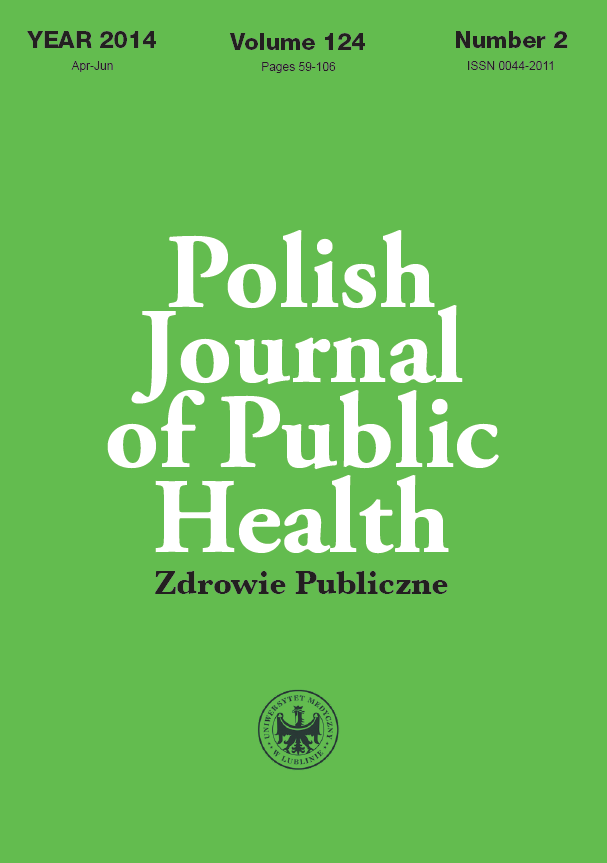An analysis of the selected sociodemographic characteristics in removable denture wearers
DOI:
https://doi.org/10.2478/pjph-2014-0015Słowa kluczowe:
removable dentures, sociodemographic characteristics, forms of paymentAbstrakt
Introduction. Dental prosthetic replacements allow restoring the masticatory function, thus contributing to proper nutrition and correct speech, and also improving facial aesthetics.
Aim. The aim of the study was to assess the selected sociodemographic characteristics of people using removable dentures (patient-paid and funded by the National Health Fund).
Material and methods. A questionnaire survey involved 321 individuals, resident in the Lubelskie Voivodship, who used removable dental prostheses. Their selected sociodemographic characteristics were analysed: age, sex, education, place of residence and material status, as well as the form of payment for prosthetic replacements. The obtained results were analysed statistically.
Results. Almost 70% of the studied population wearing removable prostheses had their dentures funded by the National Health Fund. In each age group, women used National Health Fund funded prostheses twice more frequently than men. Prostheses funded by the National Health Fund were used significantly more frequently by patients aged 51-70 years, living in cities and with a higher education level, in comparison to the respondents from other age groups, with different place of residence and education level.
Conclusions. There is correlation between sex, age, place of residence and education level of patients and the frequency of their wearing removable dentures, both patient-paid and funded by the National Health Fund.
Bibliografia
1. Schlegel-Zawadzka M, Wójcikowska A. Jakość życia człowieka dorosłego z uzupełnieniem protetycznym. Stomatol Współcz. 2013;20(1):26-34.
2. Ziętek M. Zdrowie jamy ustnej Polaków. Czas Stomatol. 2005;58:388-91.
3. Hilt A, Rybarczyk-Townsend E, Lubowiedzka-Gontarek B, Wochna-Sobańska M. Problemy zdrowotne jamy ustnej 35-44 letnich mieszkańców województwa łódzkiego. Przegl Epidemiol. 2012;66:133-8.
4. Douglas Ch, Shih A, Ostry L. Will there be a need for complete dentures in the United States in 2020? J Prosthet Dent. 2002;87:5-8.
5. Akar GC, Ergul S. The oral hygiene and denture status among residential home residents. Clin Oral Invest. 2008;12:61-5.
6. Evren BA, Uludamar A, Iseri U, Ozkan YK. The association between socioeconomic status, oral hygiene practice, denture stomatitis and oral status in elderly people living different residential homes. Arch Gerontol Geriatr. 2011;53:252-7.
7. Perea C, Suárez-Garcia MJ, Del Rio J, et al. Oral health-related quality of life in complete denture wearers depending on their socio-demographic
background, prosthetic-related factors and clinical condition. Med Oral Patol Oral Cir Bucal. 2013;18:e371-80.
8. Wochna-Sobańska M, Borysewicz-Lewicka M. Stomatologiczne potrzeby lecznicze ludności polski w świetle epidemiologicznych badań wykonanych w 2003 roku w ramach programu „Miesiąc totalnie zdrowego uśmiechu”. Czas Stomatol. 2007;60:299-305.
9. Porębska H, Lella A. „Szczerbaty ekran”. Gazeta Lek. 2010;8-9:20-1.
10. Li KY, Wong MC, Lam KF, Schwarz E. Age, period, and cohort analysis of regular dental care behavior and edentulism: A marginal approach. BMC Oral Health. 2011;11:9.
11. Pistorius J, Horn JG, Pistorius A, Kraft J. Oral health-related quality of life in patients with removable dentures. Schweiz Monatsschr Zahnmed. 2013;123:964-71.
12. Listl S. Income-related inequalities in denture-wearing by Europeans aged 50 and above. Gerodontol. 2012;29:e948-55.


